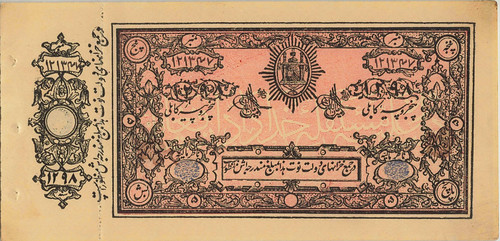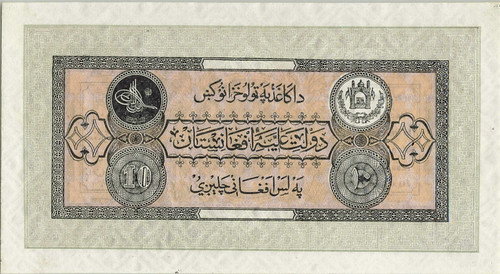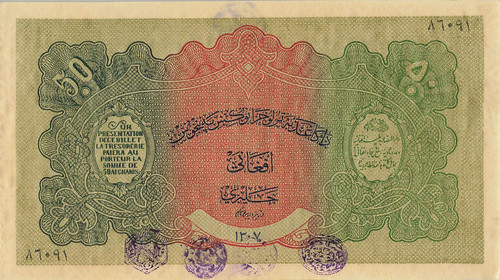
PREV ARTICLE
NEXT ARTICLE
FULL ISSUE
PREV FULL ISSUE
THE FIRST BANKNOTES FROM AFGHANISTANDennis Hengeveld of World Banknote Auctions published this blog post on Afghanistan paper money. See the firm's Kabul Collection of Afghanistan sale, ending December 22, 2021. -Editor Introduction of Paper Money in Afghanistan In August of 1919, at the conclusion of the Third Anglo-Afghan war, the country of Afghanistan severed its ties with Great Britain, which had previously had effective control over Afghanistan's foreign policy. Amanullah Khan became Emir (later King) and ended the country's isolation from the rest of the world. As part of his reforms he would introduce the first paper money in the country. The notes, which were uniface, were issued by the Afghani Treasury in four denominations: 1 Rupee (Pick-1), 5 Rupees (Pick-2), 50 Rupees (Pick-4) and 100 Rupees (Pick-5). The 1 and 5 Rupees were dated either SH1298 or SH1299 (1919 or 1920 AD respectively), while the 50 Rupees was only dated SH1298 and the 100 Rupees was only dated SH1299. The notes had a perforated left edge to which was attached a stub, which was to be removed upon issuance and kept at the Treasury. The notes were printed locally (as were all from the first two series) and carried no watermark. Afghanistan 5 Rupees SH1298 (1919 AD). The first date and part of the earliest paper money issue of Afghanistan. The stub at left contains the date and serial number and was to be retained at the Treasury after the notes were issued. Notes with the stub intact (as on this example) are worth more than notes without the stub.
New Notes Introduced A remainder of the second issue 10 Afghanis, issued SH1307 (1928 AD). Without serial numbers, this particular example was never issued into circulation. During the Afghan Civil War in the late 1920s, Habibullah Kalakani defeated Amanullah Khan and ruled Afghanistan from January to October 1929. During this period, known as the Baccha i Saqao revolution (named after the nickname of Habibullah Kalakani) examples of the 5, 10 and 50 Afghanis of the second issue that were in circulation at the time were validated with three purple handstamps. Listed in the Pick catalog as Pick-11, Pick-12 and Pick-13, all carry serial numbers and are generally in lower grades. The handstamps are usually found on either side in varying combinations. It must be noted that examples with all three handstamps clear are scarce, as most examples have at least one or more of the handstamps blurred, making them hard to read. Purple handstamps are seen on this 50 Afghanis dated SH1307 (1928 AD), indicating that it was validated during the Baccha i Saqao revolution. Unusually, this example has survived in uncirculated condition, although the majority of these revolutionary issues are found in lower grades.
A New Discovery 10 Afghanis with single black handstamp, unreported until now. Possibly a local issue or trial piece, this is definitely linked to the Baccha i Saqao revolution, although its exact significance remains unknown until now.
Conclusion
To read the complete article, see:
Wayne Homren, Editor The Numismatic Bibliomania Society is a non-profit organization promoting numismatic literature. See our web site at coinbooks.org. To submit items for publication in The E-Sylum, write to the Editor at this address: whomren@gmail.com To subscribe go to: https://my.binhost.com/lists/listinfo/esylum All Rights Reserved. NBS Home Page Contact the NBS webmaster 
|




